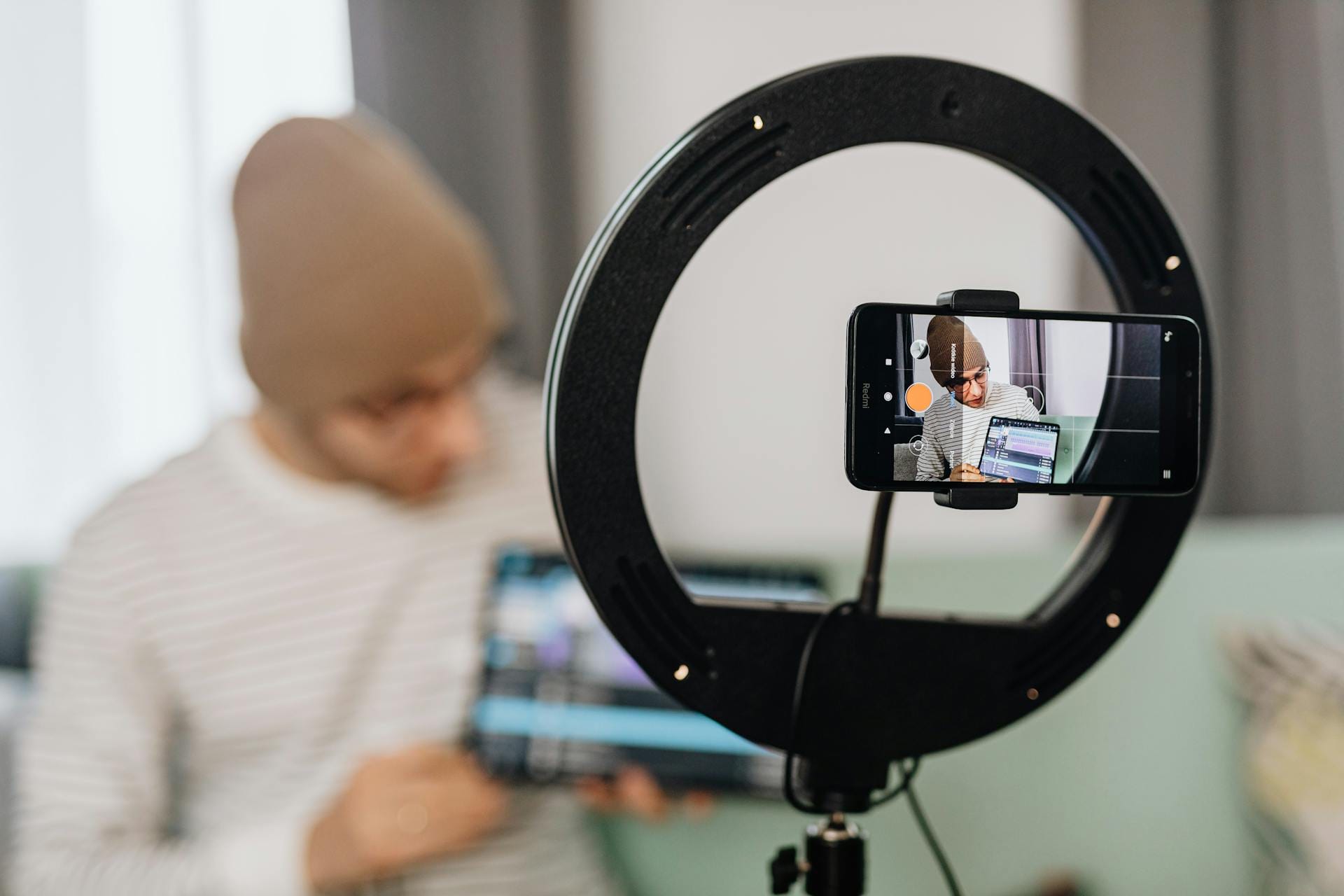
6 edits that turn a sales page from ‘good’ to ‘great’
We’ve already shared how to write six-figure sales pages, including one that has generated us hundreds of thousands of dollars. This time we want to take you into the mind of entrepreneurs who have thought about the very questions you’re probably thinking now: How do I know this is good enough? What needs to change and how can I make this better?
We’ve gathered six sales pages that have collectively generated millions of dollars and discussed the changes between an early version of the page and its current version. This way you can see the intricate thought process and nuances that go into the changes of a great sales page, and perhaps learn a thing or two to apply to your own.
For each sales page, we focus on one of the six aspects that every long-form sales page has. As a recap, these are the six main components:
- Headline
- Introduction
- Offer
- Price
- Testimonials
- Call-to-action
Let’s start with the headline.
1. Headline
As IWT staff writer Katie Parrott wrote in this article, a headline “grabs the reader by the eyeballs and says ‘YOU! I’m talking to you. Pay attention.’” Otherwise, it doesn’t matter how amazing the rest of your copy is — the reader will close it and leave it forever.
We’ll take a look at the Google doc that started the headline brainstorming process for Email Imagery, an email copywriting course that sold to a list of just 300 subscribers and generated mid-five figures, and how this entrepreneur settled on his final headline.
Email Imagery
Before

After
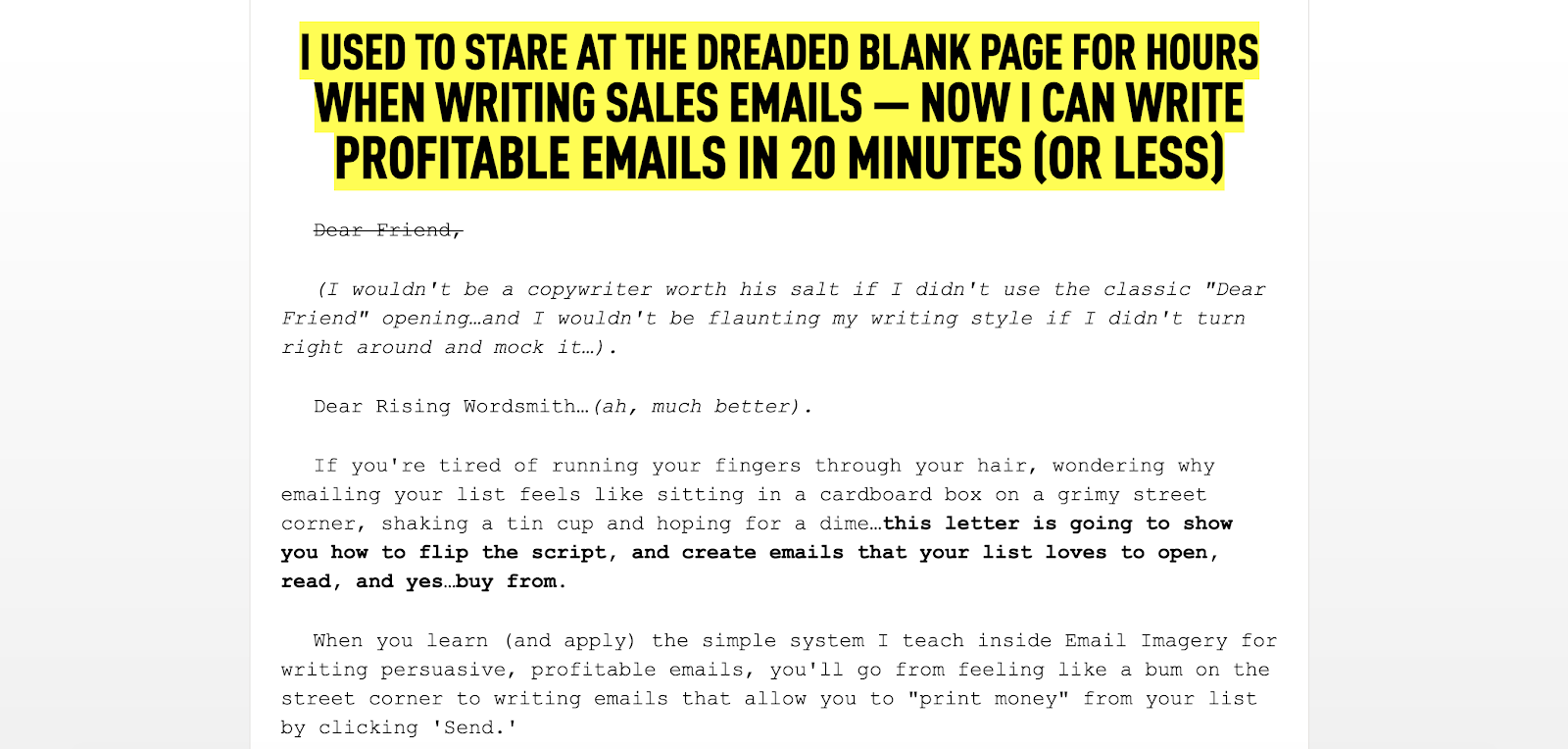
Email Imagery was created by Alex Mullan for online business owners who want to get better at writing sales emails, no matter where they are in their business.
When Mullan kicked around his initial headline ideas, he made sure they highlighted his target market’s dreams and desires. After all, he was his target market when he first started his fitness business years ago.
“The most painful themes that came up were not knowing what to write, wondering if the email I’d sent was any good, and rarely seeing results (a.k.a payment received emails). So I took each of those pain points and built a potential headline around them,” explained Mullan. The tentative headline choices in his Google doc were:
I Used To Stare At A Blank Page For Hours When Writing Sales Emails — Now I Can Write Profitable Emails In 20 Minutes (Or Less)
Are You Overcome With Crushing Waves of Anxiety And Frayed Nerves Every Time You Send Out A Sales Email?
“You Received a Payment” — If You Aren’t Seeing This Subject Line in Your Inbox, Your Sales Emails Are NOT Working…Leaving YOUR Money On The Table
These examples highlight the struggles that your prospect viscerally feels and understands. Mullan decided to lead with a slightly modified version of the first headline option:
I Used to Stare At The Dreaded Blank Page For Hours When Writing Sales Emails — Now I Can Write Profitable Emails In 20 Minutes (Or Less)
Feedback from trusted mentors pushed him toward this headline. He also considered an advanced concept called market sophistication — which is to ask how many similar products your market is already aware of or has tried. Mullan believed that his market wasn’t yet aware of their need for his product.
“I wanted to hook people in before making them aware of [the solution my course offers],” said Mullan, “[The final headline] gives me more flexibility in topics to talk about when selling in my emails. Meaning I can talk more about copy/email as a whole, and then introduce imagery as my specific solution.”
As a result of this foresight, Mullan sold out of his course in his first launch.
2. Introduction
The goal of the introduction is to show that you understand your readers. Remember: people buy to solve a problem or to feel good, so if they don’t feel that their problems are being understood they may lose interest. You don’t want to talk about your product until further down with your offer (more on that in the next section).
Let’s take a look at this million-dollar revenue sales page from Secrets of a Six-Figure Upworker.
Want to build a business that enables you to live YOUR Rich Life? Get my FREE guide on finding your first profitable idea.
Secrets of a Six-Figure Upworker
Before

After
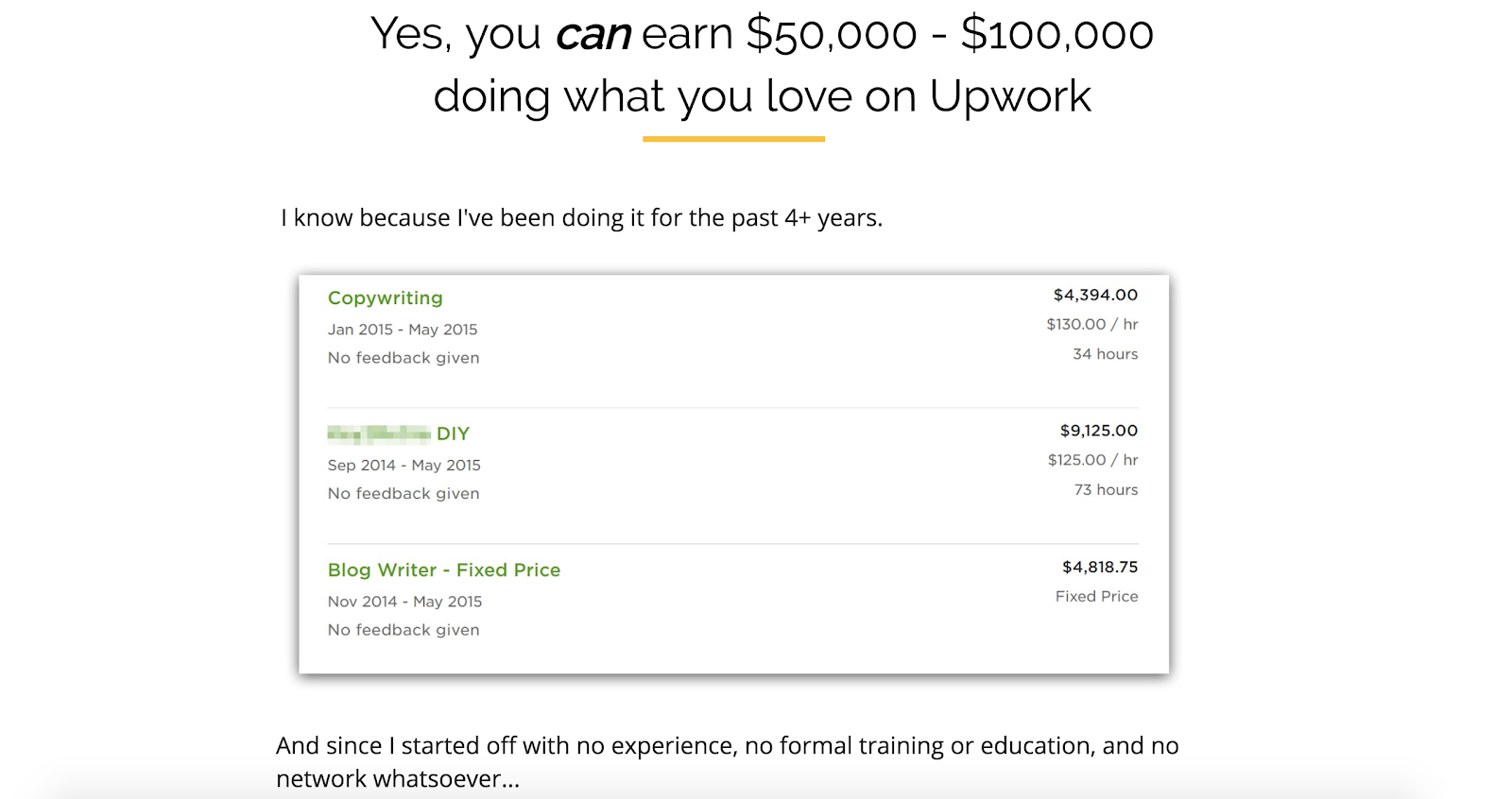
Secrets of a Six-Figure Upworker is a course that caters to aspiring freelancers who want to earn an extra $1,000, $5,000, or even $10,000+ per month via the freelance gig site Upwork.com. Upwork is notorious for presenting a high barrier to entry for brand-new or inexperienced freelancers. The course attacks this problem and provides prospects with a way to start and run their own successful freelance business, whether they have existing clout or not.
“When I told people I was able to quickly build up a six-figure freelancing income, they were like, ‘REALLY?? Tell me more!’” says Danny Margulies, the course creator. “People are smart, and if you’re writing about something compelling they will figure it out. I started my intro where I did because I believe people appreciate it when you get RIGHT to the point.”
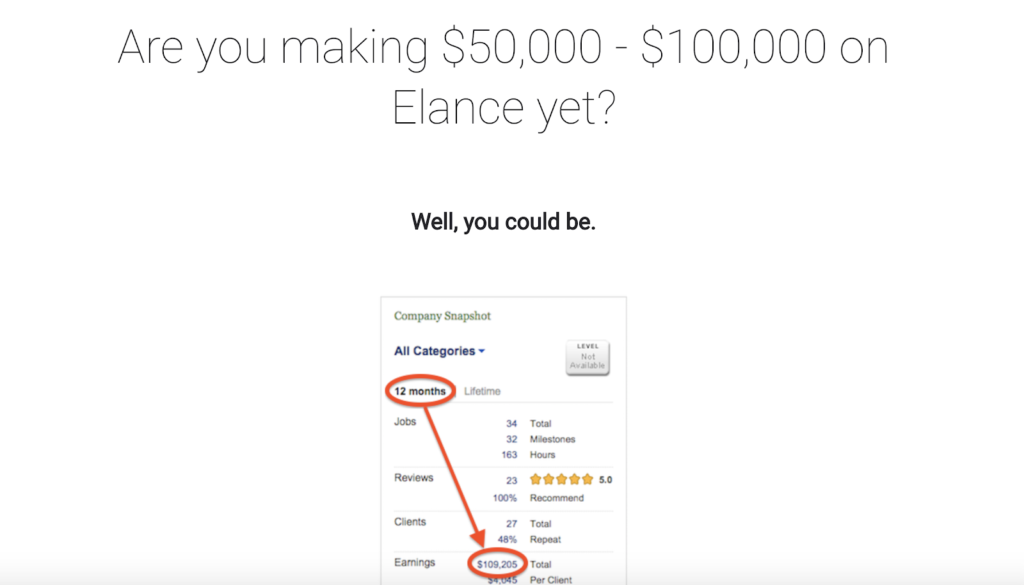
In the “after” version, Margulies wanted to highlight the most alluring parts of freelance life: earning the money people wanted (and deserved), doing work they enjoy, and having the freedom to control their own schedule. It was important to stake his claim that this is possible right out of the gates.

“I knew people would still be skeptical when they read it because there’s so much BS out there, but I figured they’d be willing to hear me out if I led with a bold statement that really connected with their hopes and dreams,” said Margulies.
Originally, he had also referred to himself as a “freelance copywriter.” He discovered that some prospects that may have been designers, programmers, video editors, and so on were hesitant to join, which prompted him to refer to himself as an “online freelancer” instead. As a result, he was able to attract a wider base of customers.
“Each time [I made an appropriate change] I would see an increase in sales and people would say, ‘Danny! I joined because you mentioned XYZ,’ and of course, it was always the exact thing I’d recently added to the copy,” said Margulies.
The key, according to Margulies, is that you don’t have to have this all figured out on your first day, or even your first month. You do the best you can and build on that over time.
3. Offer
The offer is your product: all the bells and whistles of what the paying customer will get. The offer describes all the features that will help the prospect get to their end goal. Johnson adds that the offer should be determined before the sales page is even written.
Let’s take a look at how this agency created this high-converting, free email course to get more leads.
Cross the Conversion Chasm
Before
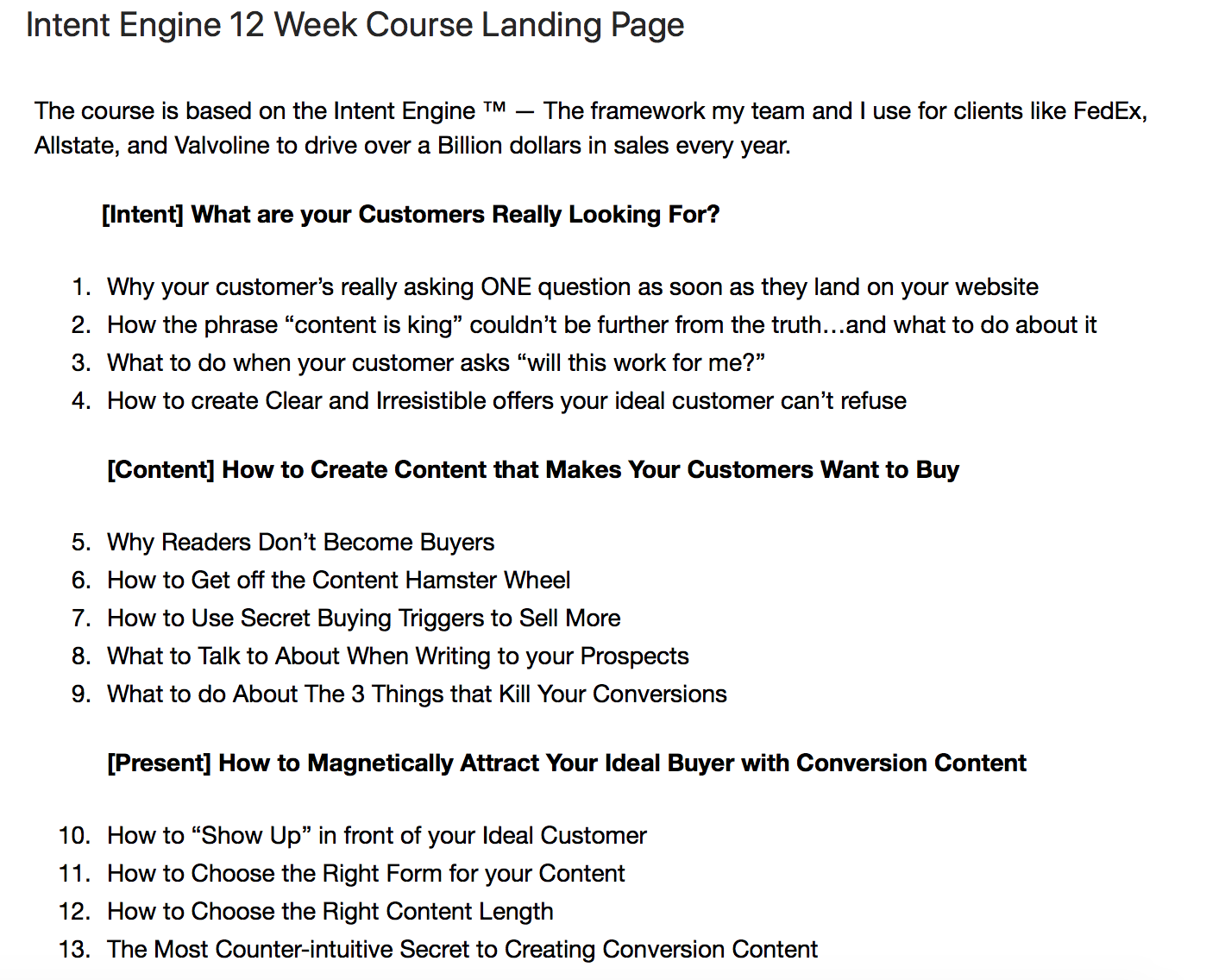
After
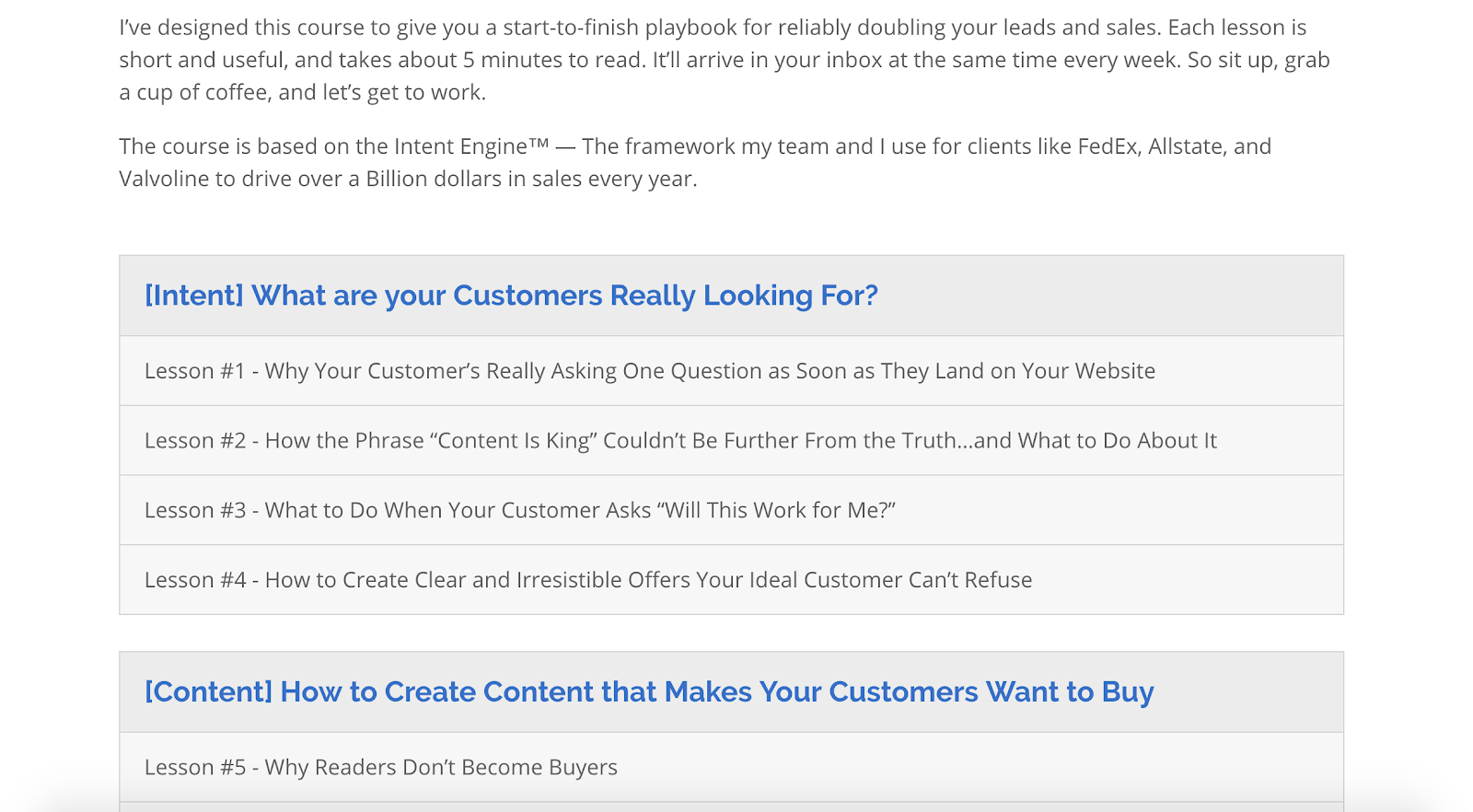
Powered By Search, a Toronto-based digital marketing agency, offered this free email course that led to potentially $1.3 million in sales. Their ideal clients are frustrated corporate marketers or seven figure–generating entrepreneurs who were stuck figuring out why their content marketing wasn’t getting the right leads.
Every lesson and component of their offer was carefully thought out. Each lesson was designed with the frustration these prospects experience, and would always end with something they can aspire to, explained Dev Basu, CEO of Powered By Search.
“I wanted to start with a question that would resonate. I wanted the reader to think ‘Man, yes, I’ve paid lots of money for traffic and it all went down the drain,’” he said.
Ultimately, he wanted a sort of connection story that would lead the prospect through the hero’s journey.
One thing to note, however, is that while the email was originally intended to drip over 12 weeks, Basu’s other audience’s — entrepreneurs — main feedback was that they hated waiting for a lesson each week. They wanted things fast. Based on this feedback, they gave the prospect the option to receive these emails daily or weekly upon sign-up.
Basu also added what the prospect can expect in each lesson, including where they’ll find it (in their inbox) and the time it’d take to read (which, for busy entrepreneurs, can be a huge deal).
4. Price
The price should be strategically placed further down the page so that by the time the prospect reaches the price they are shouting, “Shut up and take my money!” Or at least that’s the ideal outcome. To pre-empt the fears and concerns around buying a dud, you’ll typically see a “money-back guarantee” of some sort.
Pricing psychology can be highly nuanced and complex, but for the sake of this article we will look at how this entrepreneur changed her entire pricing structure.
Learn to take control of your finances and spend your money GUILT-FREE with our free Ultimate Guide To Personal Finance below:
Starve Mode
Before
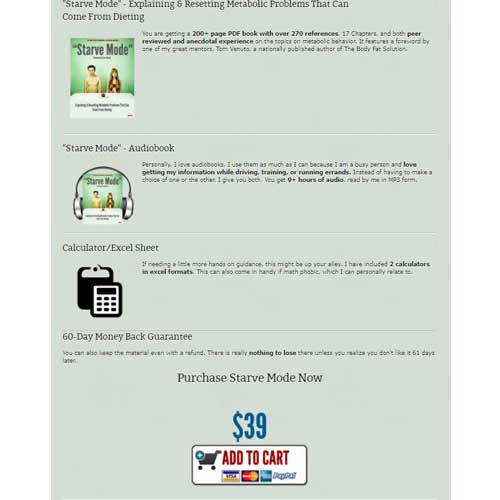
After

Created by Leigh Peele, a fat loss specialist and coach, “Starve Mode” is a book about weight loss. Its prospective customer is not a complete beginner and has likely been burned by all the misleading information they’ve found on Google and unethical gurus.
Peele confided that she had always struggled with price of the book. Her recent change to her pricing structure led to a sales increase of 400% from just organic traffic and zero promotion.
Until her most recent change, Peele had one set price for “Starve Mode” and its bonus offers ($39). The click-to-buy button led to upsells, which Peele determined was not ideal for her brand.
“After doing split-testing [of upsell options], I had better conversions with my particular audience when I put everything up front. Asking a few [people] in my audience, they told me it increased trust value and made me look a little less ‘shady,’” said Peele.
Appearing less “shady” is important. Peele, after all, is competing in a market that is known for bogus info-products and every-guru claiming their product is the magic bullet people need. Peele and her team are 100% behind their product and believed it could be offered at a higher price point.
And so, Peele switched from one catch-all price to a three-tier pricing structure.
One of the reasons? Her business (and costs) grew, and she had to price her work accordingly.
“I knew the content price and material are worth it, and high quality equals a higher level of overhead,” said Peele.
Once the design came together, the copy almost took care of itself, said Peele. She emphasized basic features of the product, provided a preview PDF of the content, and gave options to her other products. As a result, the whole thing looks and reads more to-the-point.
“Having a newly designed site gave me more confidence to increase my price and thus far I’ve not only sold more product, I’ve sold more product at a higher price range,” said Peele.
5. Testimonials
The purpose of testimonials — to help neutralize objections via success stories from previous happy customers — is simple in theory. In execution, however, directing a customer to tell the “right” story can be tricky.
You don’t want to just sprinkle “Look how awesome this thing is” willy-nilly. You want these testimonials to be believable to help allay the prospect’s concerns and doubts. Here’s how this language course changed its approach to their testimonials.
French Together
Before

After

Pulling in about $4,500 per month, the course French Together teaches beginning French learners how to get comfortable with speaking this language of love. On the sales page the course creator, Benjamin Houy, empathizes with a particular pain point: that the prospective customer has tried to learn, albeit incorrectly, and tried to use it in France, only to feel embarrassed by their attempts and revert back to English.
Houy’s course focuses on instilling in them the confidence that they can learn and speak French well — without the embarrassment.
At first, Houy’s early testimonials didn’t say anything about how the person used the course. The best testimonials are believable (e.g., are real people and include full names, links, videos, screenshots of proof, etc.) and focus on specific talking points that relate to whatever you are talking about on your sales page. So Houy needed to audit his approach to testimonials.
He asked questions like: what was the obstacle that would have prevented you from buying this course; what did you find as a result of using this course; what specific feature did you like most about this course; would you recommend this course?
As a result, Houy made his testimonials more focused on the customer’s story of their struggle and how they used the course to solve their problem — which was that they hesitated to even use their language skills!
“When I start a testimonial by highlighting the doubts people had before buying and the problems the course solved, I find that the testimonials are more believable, but also help to answer objections that may not have been addressed elsewhere in the copy,” explained Houy.
Houy said of the change: “After publishing the new testimonials, I quickly got feedback from buyers saying the testimonials had convinced them because they could relate.”
6. Call-to-action
A good call-to-action is like the tasty bait on a fishing line: you want the prospect to bite and do so with conviction. The stronger the call-to-action (CTA), the more you’re able to push your prospects toward whatever it is you want them to do: buy, sign up, learn more, send fan mail, and so forth.
Magicsheets
Before
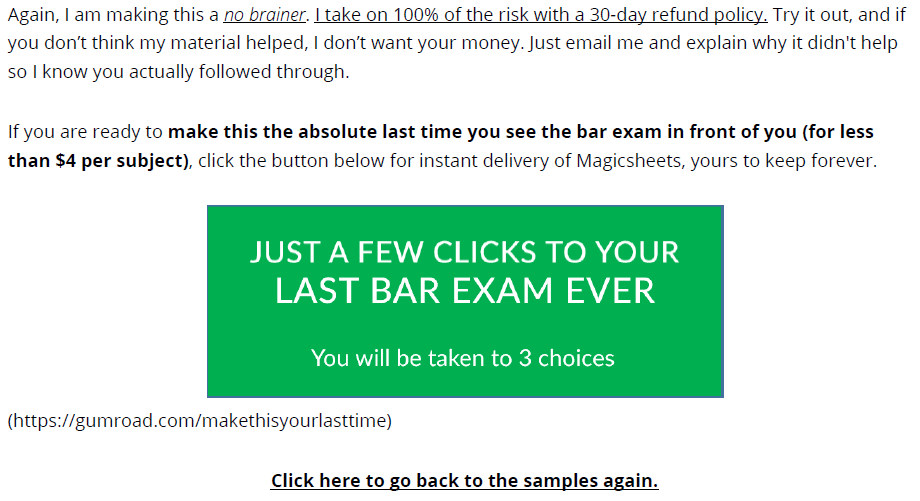
After
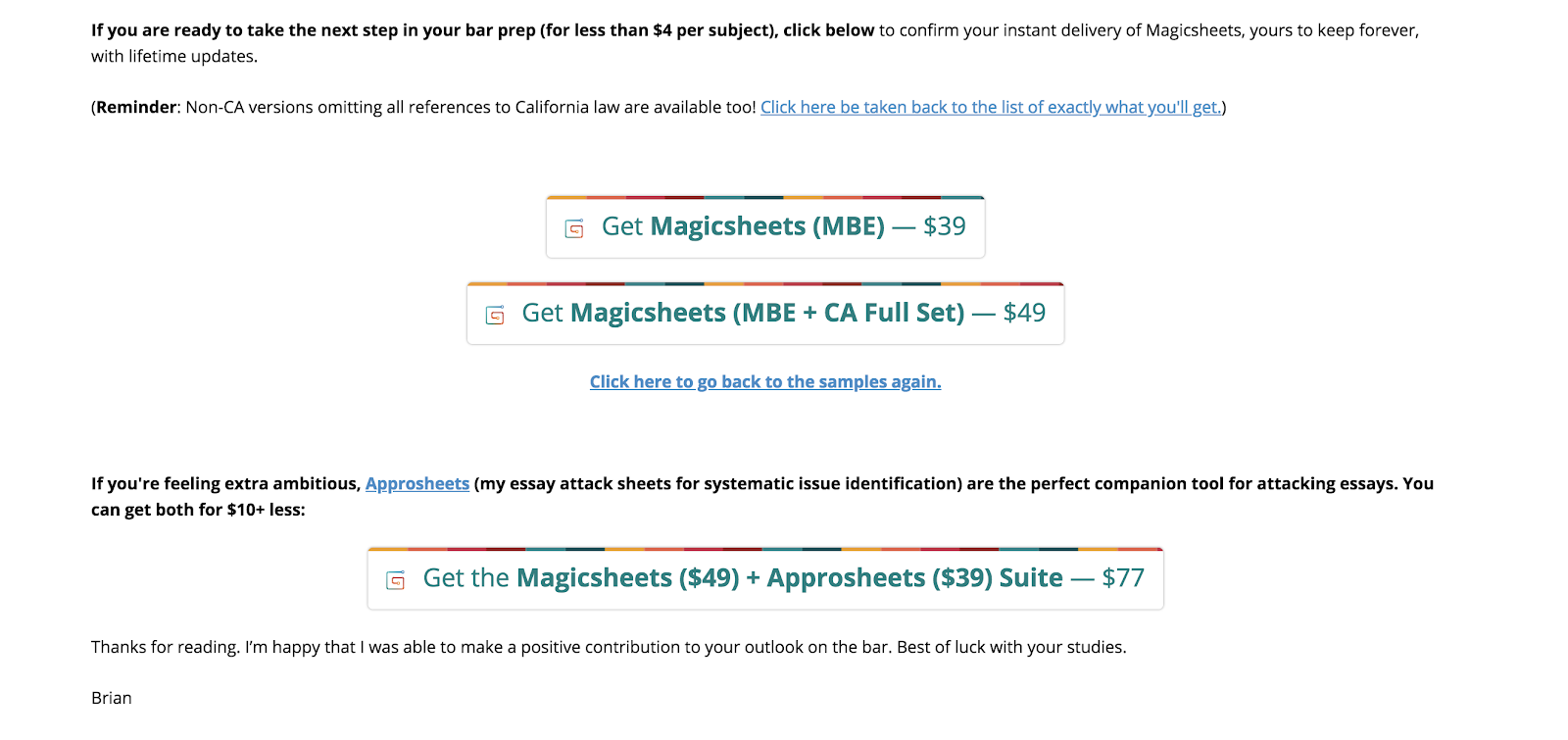
Brian Hahn understands the struggle of being a law student and preparing for the daunting bar exam, so he created Magicsheets and other similar study aids for law school. He made $42,420 last year selling these study guides to law students and graduates preparing for the bar.
“In this early version of the CTA, I used a button — just an image linked to my Gumroad profile to bring attention to where [the customer] can finally ‘BUY NOW!’ after my totally whimsical and long-winded explanation of why they need this $49 product,” explained Hahn.
He got an extra vote of confidence from someone he’d trusted, who liked the button, and so he stuck with it. It worked.
Eventually, though, he changed it.
A few things to note in the “after” version.
First, Hahn addressed a crucial frequently asked question from bar takers located in California (which tests differently) to assure them that this product can aid them in their studying as well (crucial detail to assuage doubts).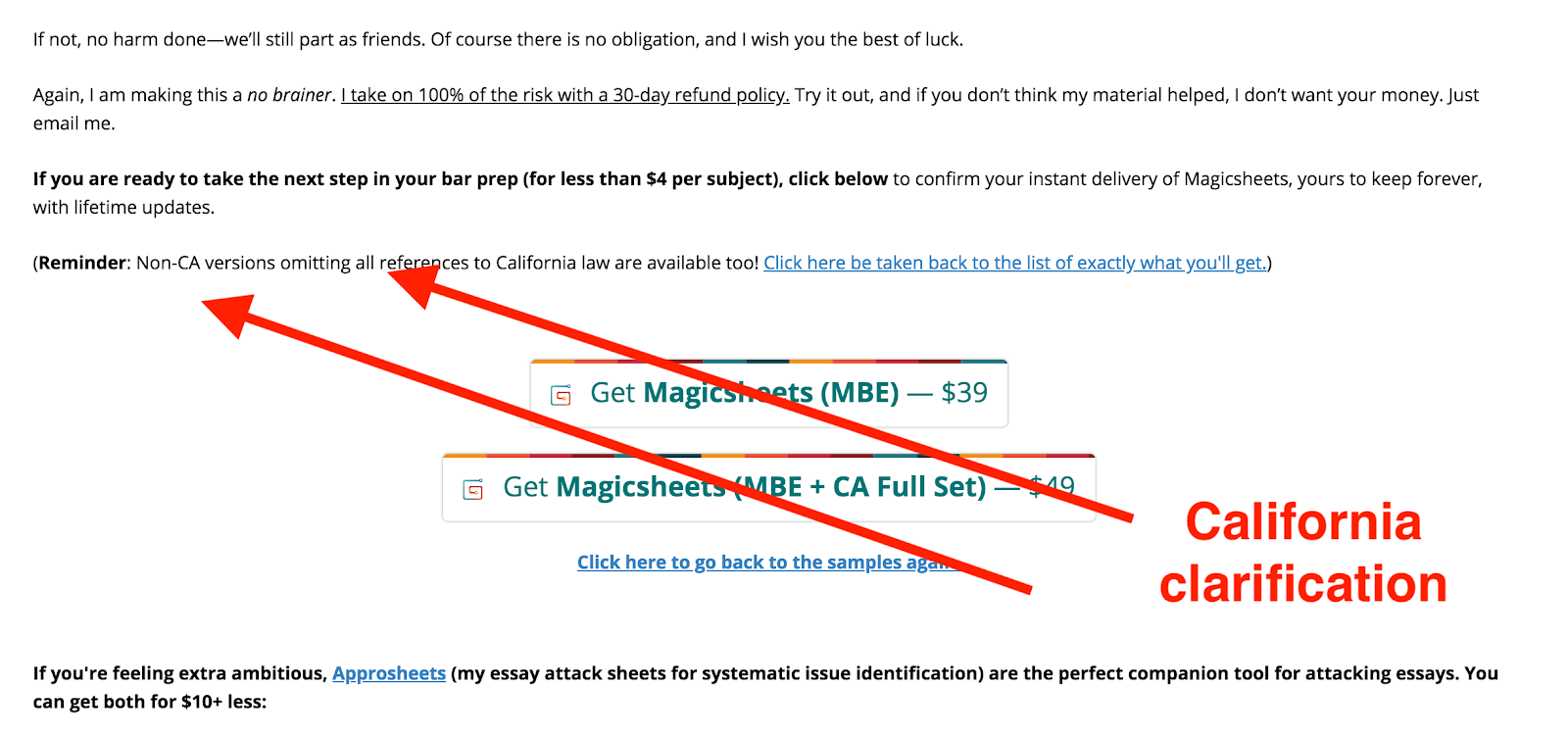
Second, he removed the “You will be taken to three choices” from the “before” version. He thought this was unnecessary and a cause for confusion for the prospect: Where would that take them? Why not just lay it all out up front?
Now he has actual buttons for two versions of his product — “Get Magicsheets” — along with a button to buy the bundled version. Hahn also added strong testimonials before and after the CTA to help the prospect overcome their hesitations.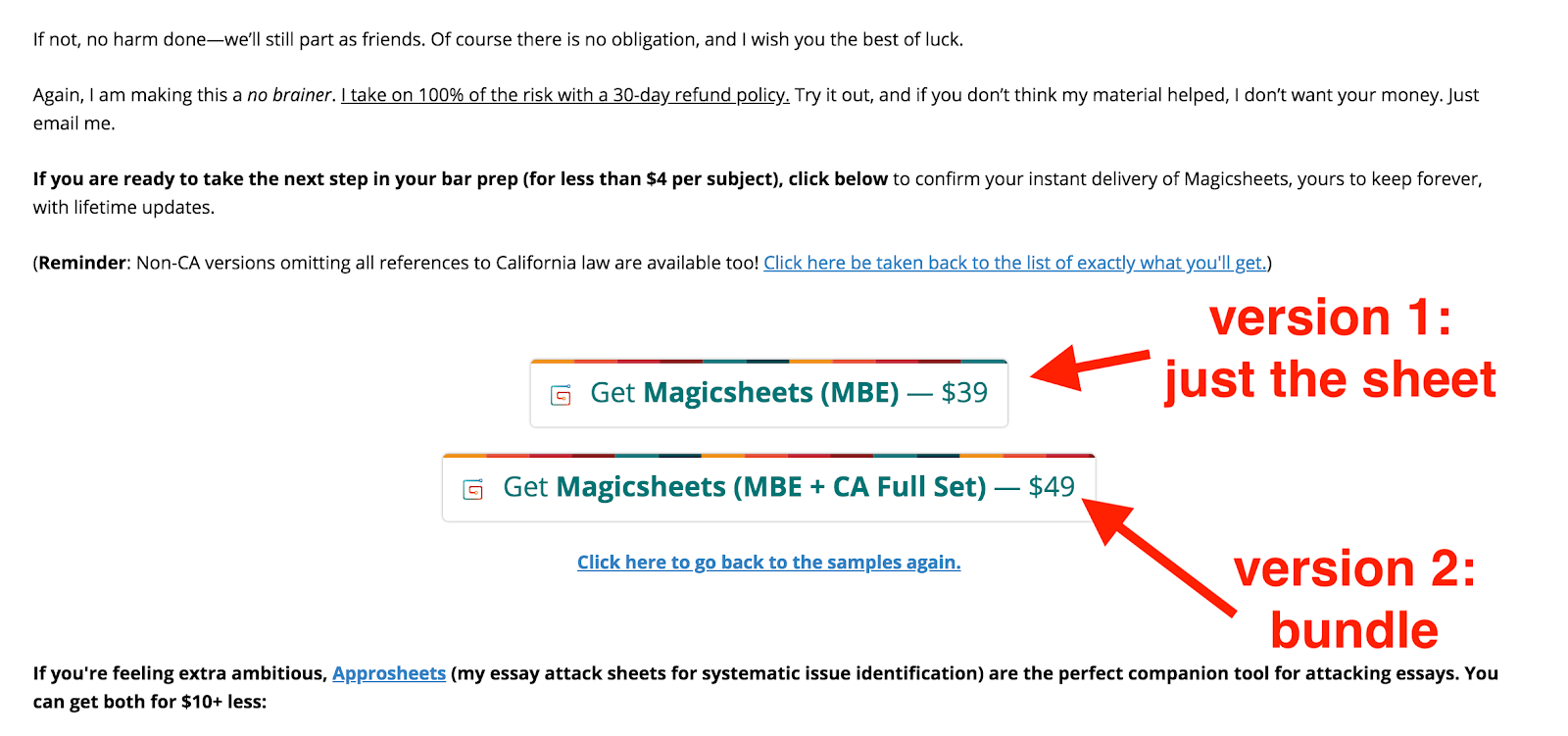
“It’s a simple call-to-action that I tried to make relatable,” said Hahn. ***
Bottom-line: Copy that moves people to act doesn’t happen by chance. It takes careful research and deliberate thought, but also editing and making constant tweaks.
If there’s one thing that all of these sales pages demonstrate, it’s that there’s no ONE right way to approach sales copy. And you won’t know that your sales page (or changes to it) is effective until you put it out into the wild.



